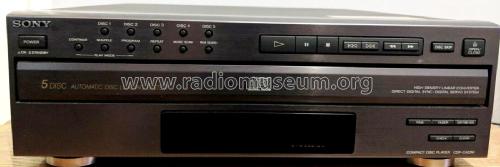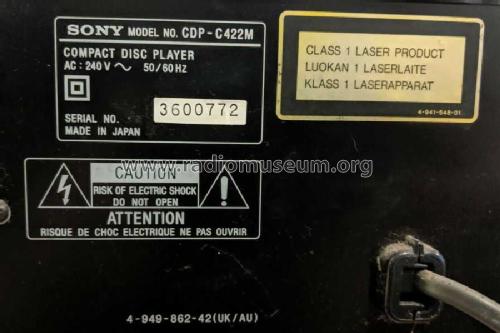Compact Disc Player CDP-C422M
Sony Corporation; Tokyo
- Country
- Japan
- Manufacturer / Brand
- Sony Corporation; Tokyo
- Year
- 1993 ?
- Category
- Sound/Video Recorder and/or Player
- Radiomuseum.org ID
- 317344
- Number of Transistors
- Semiconductors present.
- Semiconductors
- Main principle
- Audio-Amplification
- Wave bands
- - without
- Details
- CD-Player, -Writer, MD, MOD (audio); Hi-Fi equipment
- Power type and voltage
- Alternating Current supply (AC) / 220-230; 240; 110-120; 220-240 Volt
- Loudspeaker
- - For headphones or amp.
- Material
- Metal case
- from Radiomuseum.org
- Model: Compact Disc Player CDP-C422M - Sony Corporation; Tokyo
- Shape
- Book-shelf unit.
- Dimensions (WHD)
- 355 x 120 x 385 mm / 14 x 4.7 x 15.2 inch
- Notes
-
A midi size stereo hi-fi 5 disc carousel changer compact disc player. High Density Linear Converter, Direct Digital Sync./ Digital Servo System, 5 Disc Automatic Disc Loading System. RCA phono sockets for Line Out.
Specification System Compact disc digital audio system Laser (KSS-240A) Semiconductor laser (λ = 780 nm)
Emission duration: continuousFrequency response 2 Hz - 20 kHz (±0.5 dB) Signal to noise ratio More than 100 dB Dynamic range More than 98 dB Harmonic distortion Less than 0.005% Channel separation More than 100 dB Wow and flutter Below measurable limit Outputs LINE OUT
(phono jacks)Output level 2V (at 50 kΩ)
Load impedance over 10 kΩVersions/Power requirements
AEP model / 220-230V AC 50/60Hz
UK model / 240V AC 50/60Hz
Australian model / 240V AC 50/60Hz
E model / 110-120V, 220-240V AC 50/60Hz adjustablePower consumption: 12 W
Similar to the Sony CDP-C325M Compact Disc Player which has a remote control and a jack for headphones.
- Net weight (2.2 lb = 1 kg)
- 5 kg / 11 lb 0.2 oz (11.013 lb)
- Literature/Schematics (1)
- - - Manufacturers Literature (Service manual CDP-325M/C422M dated 1993.6)
- Author
- Model page created by Howard Craven. See "Data change" for further contributors.
- Other Models
-
Here you find 3913 models, 3773 with images and 947 with schematics for wireless sets etc. In French: TSF for Télégraphie sans fil.
All listed radios etc. from Sony Corporation; Tokyo


